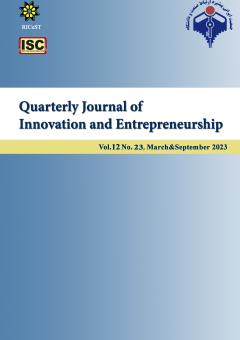Identifying social banking innovation process components with digital transformation approach by fuzzy Delphi method
Subject Areas : تخصصی
َAli Mahmoodi
1
,
Abbas Khamseh
2
*
![]() ,
Mehrdad Hosseini Shakib
3
,
Mehrdad Hosseini Shakib
3
![]()
1 - PhD Student in Technology Management, Department of Management, Roudhen Branch, Islamic Azad University, Roudhen, Iran
2 - Associate Prof. Department of Industrial Management, Karaj Branch, Islamic Azad University, Karaj, Iran
3 - Assistant Prof, Department of Industrial Management, Karaj Branch, Islamic Azad University, Karaj, Iran
Keywords: Innovation, Social Banking, Process, Digital Transformation, Fuzzy Delphi,
Abstract :
This article aims to present the model of social banking innovation process with digital transformation approach by fuzzy Delphi method, which is applied in terms of purpose and qualitative research in terms of data collection. The statistical population includes all university experts and senior bank managers who were selected for the Delphi process using 16 people using the snowball technique. The collection tool in this study is the Delphi questionnaire. Indicators were collected using fuzzy Delphi technique. The validity of the research was obtained by agreement of experts and validity with the help of consensus and formal validity. The results showed that during the three stages of the survey of 66 components, the final model has 43 components and has 6 dimensions. Based on the results obtained from fuzzy Delphi method and research literature was expressed. The 43 factors (indices) identified and approved by experts are the basis of the formation of the research model, which are classified into 6 separate groups: 1- Social factors (SF), 2- Rules and policies (RP), 3- Digital transformation infrastructure (DTI), 4- Innovative approach (IA), 5- Security (S) and 6- Banking industry structure (SBI)
1. اسدامرجی، ا.، و محمدیان، ا.، و رجب زاده قطری، ع.، و شعار، م. (1398). ارائه مدل بلوغ قابلیت تحول دیجیتال با استفاده از روش فراترکیب: موردمطالعه شرکت های دارویی. مدیریت اطلاعات. 5(2), 48-69.
2. اعتمادی فرد، ع.، طبائیان، ک.، پیله وری، ن.، و خمسه، ع. (1400). طراحی مدل توسعه یکپارچه نوآوری خدمات بانکداری الکترونیک براساس قابلیت های پویا با استفاده از میک مک فازی. نوآوری و ارزش آفرینی، 10(20 )، 147-166.
3. بوجادزیف، جرج.، بوجادزیف، ماریا. (1381). منطق فازي و کاربرد آن در مدیریت. ترجمه: سید محمد حسینی، تهران، چاپ اول، محل نشر: انتشارات ایشیق.
4. سلطان زاده، ج.، قادری فر، ا. و صوفی رضایی، ح.،(1401).تاثیر توانمندیهای بنگاه بر عملکرد نوآوری شرکتهای دانش بنیان ایران. نوآوری و ارزش آفرینی. 11(21) ،117-134.
5. سیف اللهی، ناصر، ابراهیمی خراجو، وحیده (1401). بررسی بانکداری اجتماعی در دنیا برای صنایع کوچک و ارائه راهحل چگونگی تعمیم آن در اردبیل، اقتصاد مالی، 16(59)، 75-104.
6. نسیمی، م.، و زارع، آ. (1399). رابطه حمایت از مسئولیت اجتماعی سازمان و عملکرد شغلی کارکنان با نقش شناسایی سازمانی و مشتری مداری. توسعه مدیریت و منابع انسانی و پشتیبانی. 15(55 ), 104-129.
7. . Cheng, Ching-Hsue & Lin, Yin. (2002). "Evaluating the best mail battle tank using fuzzy decision theory with linguistic criteria evaluation”, European Journal of Operational Research, vol.142, p.147.
8. Busulwa, R. Pickering, M. Mao, I (2022). Digital transformation and hospitality management competencies: Toward an integrative framework, International Journal of Hospitality Management, 102.
9. Das, S. (2020). Innovations in Digital Banking Service Brand Equity and Millennial Consumerism. In Digital Transformation and Innovative Services for Business and Learning (62-79). IGI Global.
10. Elia, G., Margherita, A., & Passiante, G. (2020). "Digital entrepreneurship ecosystem: How digital technologies and collective intelligence are reshaping the entrepreneurial process," Technological Forecasting and Social Change, Elsevier, vol. 150(C).
11. Khamseh, A., Mirfallah Lialestani, M. A., & Radfar, R. (2021) .Digital Transformation Model, Based on Grounded Theory. Journal of Information Systems and Telecommunication (JIST), 4(36), 275.
12. Naimi-Sadigh, A., Asgari, T., & Rabiei, M. (2022). Digital transformation in the value chain disruption of banking services. Journal of the Knowledge Economy, 13(2), 1212-1242.
13. Popov, S. B., & Khripunov, P. V. (2019, November). Digital Transformation Legacy Social Service Information System. In Journal of Physics: Conference Series (Vol. 1368, No. 5, p. 052019). IOP Publishing.
14. Ramzan, M., Amin, M. & Abbas, M. (2021). How does corporate social responsibility affect financial performance, financial stability, and financial inclusion in the banking sector? Evidence from Pakistan, Research in International Business and Finance55, 101314.
15. Rushchyshyn, N., Kulinich, O., Tvorydlo, O., Mikhailov, A., & Viunyk, O. (2022). State Regulation of Banking Business in the Context of Social and Digital Transformation of the Economy. International Journal of Computer Science & Network Security, 22(4), 67-72.
16. Stepantseva, A. (2020). Digital Transformation of Business Models in the banking sector: a multiple case study/submitted by Stepantseva Anna (Doctoral dissertation, Universität Linz).
17. Vial, G. (2019). Understanding digital transformation: A review and a research agenda. The journal of strategic information systems, 28(2), 118-144.
18. Votintseva, L., Andreeva, M., Kovalenin, I., & Votintsev, R. (2019, March). Digital transformation of Russian banking institutions: assessments and prospects. In IOP Conference Series: Materials Science and Engineering (Vol. 497, No. 1, p. 012101). IOP Publishing.
19. Winasis, S., Terminanto, A., & Badawi, A. (2018). Building a winning Team: casae of tanah abang main Branch, orivate Bank ABC. In Internasional Conference on Industrial Engineering and Operations Management.
20. . Winasis, S., Diumarno, Ryanto & Ariyanto. (2020). Digital Transformation in the Indonesian Banking Industry: Impact on Employee Engagement, International Journal of Innovation, Creativity and Change, Volume 12, Issue 4, 2020.
21. Zalutska, K., Pasichnyk, V., Smolinska, N., Grybyk, I., & Antonova, L. (2022). Features of the Impact of Social and Digital Changes on the System of Government Regulation of Banking Activity. International Journal of Computer Science & Network Security, 22(4), 217.

